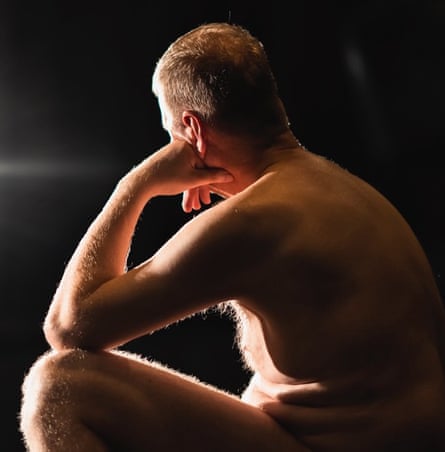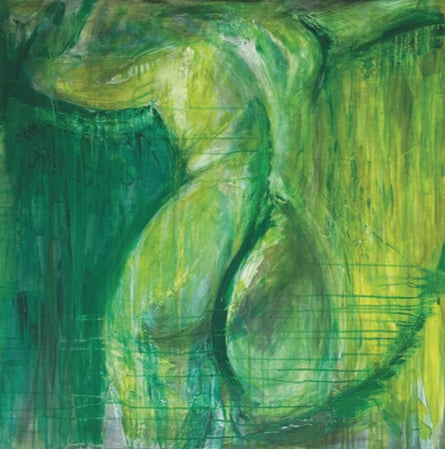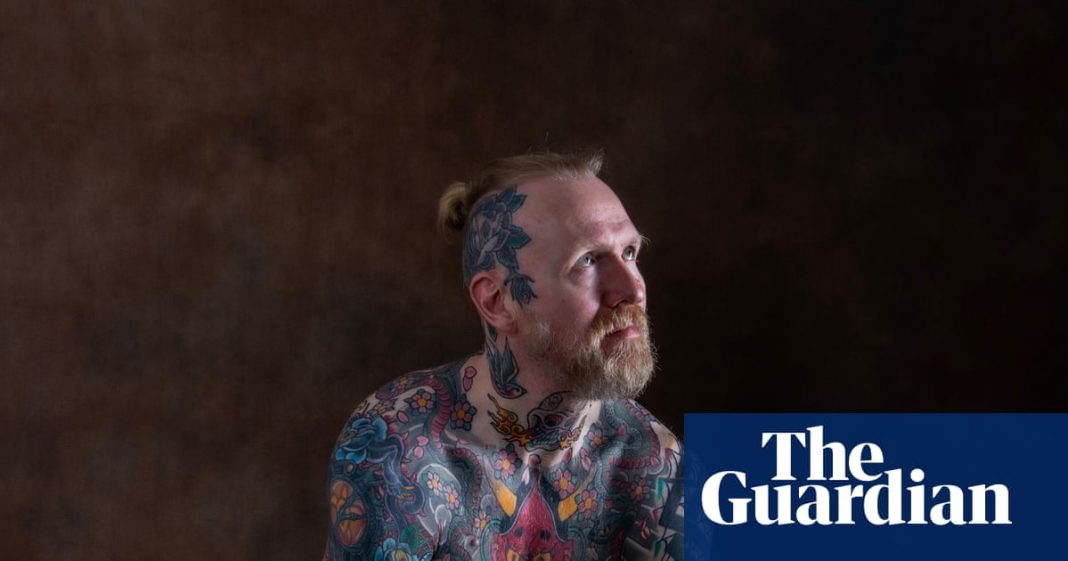‘It has changed my life’
Craig, 54 (@tattooed_nude)
I started life modelling 18 months ago. My mum said: “You’re getting all these tattoos and no one gets to see them.” That triggered something in me. I’ve always loved art and I wanted to see how artists would respond to my tattoos.
I replied to a local advert looking for life models on Instagram. I was only given two hours’ notice before my first class, because another model had dropped out. There were 30 to 40 people there – I’d never been naked in front of so many people before.
I felt very self-conscious and vulnerable. It was like an out-of-body experience. Now, I usually forget all about my nudity – and I’m always getting great feedback on my poses. I base them on the Austrian painter Egon Schiele’s work: I make them quite angular and dynamic, and use my hands a lot.
It’s a very physical job. I feel a responsibility to get into interesting and adventurous poses that will inspire the artists. I never feel bored, but sometimes I wish a pose would end. If you stay in any position long enough, it becomes uncomfortable. I’ve had dead legs that have taken days to recover, as well as back and neck ache.
I’ve never done yoga or gymnastics, but I do work out using kettlebells. I’ve spent about £35,000 on my tattoos and I don’t want to lose my shape and distort them. While some more traditional classes refuse to hire me because of my tattoos, other artists want to draw a model who’s a bit different or will inspire them to be more expressive with colour. I force them out of their comfort zone and that’s really rewarding for me.
Becoming a life model has changed my life. I travel around the country now, mixing in artists’ circles and feeling more like an insider in the art world. I used to visit exhibitions – now I’m in them and I meet the artists afterwards. I typically earn £20 to £25 an hour, and some artists give me their work afterwards. I display the best ones in my studio flat, though I turn them to face the wall when my mum and sister visit.
A lot of my classes are for young people, such as sixth formers. Although I’m 54, I don’t feel uncomfortable about that – drawing from a live model is an important part of their development as artists. They could be the next Jenny Saville.
‘When I uncovered my naked body, I was waiting for the laughter’
Geoff, 56 (@yorkslifemodel)

I have attention deficit hyperactivity disorder (ADHD) and I am super shy and quiet. But I wanted a hobby, so I took an adult education class to learn how to draw. For two years, I didn’t really speak to anyone in the class. Then, at our regular weekly life drawing class, the model didn’t show up. I surprised myself by saying: “I’ll do it.”
I volunteered because, for more than 40 years, I had hated my body. I started puberty early and was bullied by other children for being circumcised, and then, as an uncontrollable, non-sexual reaction to feeling intensely embarrassed, getting an erection at school. Gangs of boys and girls would chase after me, calling me names and laughing at me to trigger this reaction. It went on for years.
For decades afterwards, I never wanted anyone to see me naked – or even to see myself naked – because it just brought back the voices and the laughter. I call those memories “the shadows”, because they feel like darkness coming over me.
That day in my life drawing class, I thought: ‘I can’t keep living with this shame. I’ve got to try to get over it.’
As soon as I uncovered my naked body, I was waiting for the laughter. As usual, I heard the voices in my head laughing. But in the room, it was calm. It was relaxing. People just sat there, drawing me.
At breaktime, I started talking to my classmates for the first time. We chatted about their drawings, and it was all perfectly normal. Even though they’d seen me naked, they treated me with respect.
It felt so empowering. So I did it again, and again nobody laughed. Now, eight years later, I model about once a fortnight and every time I do it, I feel stronger, like another piece of me has been repaired. It’s given me a huge amount of confidence, which has helped me in my job, and I’ve made good friends doing it, too.
It even helps me with my ADHD. Normally, I can’t do just one thing, but in a life drawing class, I can, because I am locked in place – and I have to keep my mind focused on my poses and what I’m doing in the present moment so that I don’t move. My mind becomes so relaxed, I feel euphoric. It gives me inner peace.
I also love seeing the artworks people have made afterwards, how they have interpreted my pose and been inspired by it. Their art helps me to see my naked body in a new light. Now, if I ever feel down, and the shadows start to creep in, I look at the pictures those artists have created. And I think: ‘That’s me.’
‘A woman in her 50s can be very in tune with her own body’
Cecile, 56 (@CMRobertina_lifemodel)
When I came out of a 22-year relationship, which was not very physical, I began to rediscover my sexuality as a woman in her 50s. I was also finding myself as an artist and became interested in drawing and painting my body and other female nudes, which have always been important in art history. I decided to go to a life drawing class.
The model, a woman in her 30s, seemed very uncomfortable posing – it was her first time. And I thought: I should do that, I would have no shame. A woman in her 50s can be very in tune with her own body and not embarrassed. I’m also from the Netherlands, where we are more relaxed about nudity. I wanted to make a statement: this is just normal. This is art.
Part of me is a bit of an exhibitionist, too, and after I started life modelling two years ago, I grew in confidence. I don’t wear makeup, I believe in natural beauty, I feel no pressure to lose weight or become toned. I have pubic hair and I get feedback from groups like: ‘You are our favourite model, because you have so many lovely curves.’ It’s all about how I carry myself: I can communicate “this is who I am” with my body.

I’m fascinated by the way other artists portray me. Sometimes, they really capture my sensuality and what I was trying to get across with a pose.
Recently, I was diagnosed with breast cancer after going for a routine mammogram. I had to have some of my milk ducts and lymph nodes removed, so I have scars on my body from that. But I have carried on modelling, which I find empowering.
I’ve got a drawer full of nude drawings of me now, as well as self-portraits of my naked body. I’ll show them to everybody. I feel proud of them.
‘It’s made me confident about accepting my body as a queer man’
Dwayne, 40 (@DMAClifedrawing)
I’m a self-employed graphic artist and illustrator. My work is quite solitary, so about four years ago, I decided to try life modelling. I thought it would be an opportunity to meet other artists and make a bit of extra money.
I was a little anxious at first but all the artists were respectful. I now model three times a week on average and have found a sense of community with other life models. We are all very supportive of one another. I feel welcomed and understood.
I dance in my spare time, and through life modelling I realised that makes me pose and move differently to other people. I am very aware of my core and familiar with my body, and I know which poses I can maintain for long periods without injuring myself.
I also use my skills as an artist to think about poses that will allow the artists around me to create an interesting drawing from whatever angle they can see me.
After the class, I love seeing multiple approaches to the same pose. It’s exciting how people respond to me differently depending on their skill level, background or the medium they use. Sometimes, I can see an artist has captured something no one else has noticed. I see it as an exchange of energy, that my body has allowed them to create these lines. I find it inspiring.
It’s also made me feel very confident about accepting my body – as a queer man – the way that it is.
Being naked in a non-sexualised space where I am not judged by society’s norms makes me feel very liberated. I feel free.
‘It has helped me see the beauty in my own body’
Ade, 37 (@heymachomei)
I never thought I would get into life modelling. I’m Chinese Singaporean and, traditionally, we’re conservative. It is quite taboo to reveal your body and you don’t see that many Asian people doing life modelling. Culturally, it’s not widely accepted or comfortable for a lot of people.
But as a burlesque and drag performer, I am already quite provocative. And every time I have modelled, it has felt like a safe, nonjudgmental space.
I usually wear at least a thong when I’m posing, sometimes lingerie or a revealing costume. I don’t think it’s absolutely necessary to be completely nude. Art students can still observe the muscle and bone structure of my body.
-
‘When we lay our bodies bare for artists, we make a powerful statement that queer, non-binary and trans bodies are beautiful.’ Photograph: @sohoschoolofburlesque
I like challenging artists to leave their perceptions of gender at the door when they enter a life drawing class. Being non-binary, I have a very androgynous look because I’m quite muscular, I have a buzz cut and I hold my body in quite a masculine way, despite being obviously born female.
When I pose, I like standing. I choose dynamic, strength poses that show off my muscle structure. I usually look for a juxtaposition in the artwork afterwards, a different kind of observation – a sense that the artist isn’t just drawing my body, they are observing who I am as a person.
Life modelling has opened my eyes to the amazing artistic talent that is around me – and that, in turn, has helped me to see the beauty in my own body. If more transgender and non-binary people were to get into life modelling, I think that would be incredible. When we lay our bodies bare for artists, we make a really powerful statement that queer, non-binary and trans bodies exist and are beautiful and deserve to be made into art.


